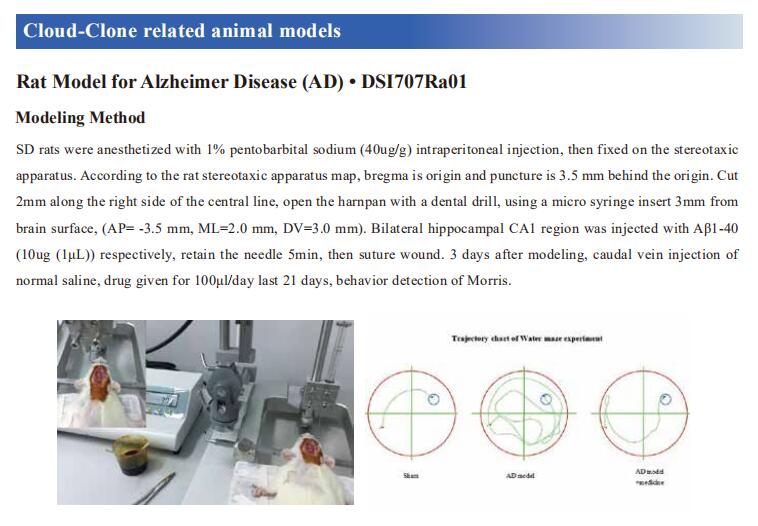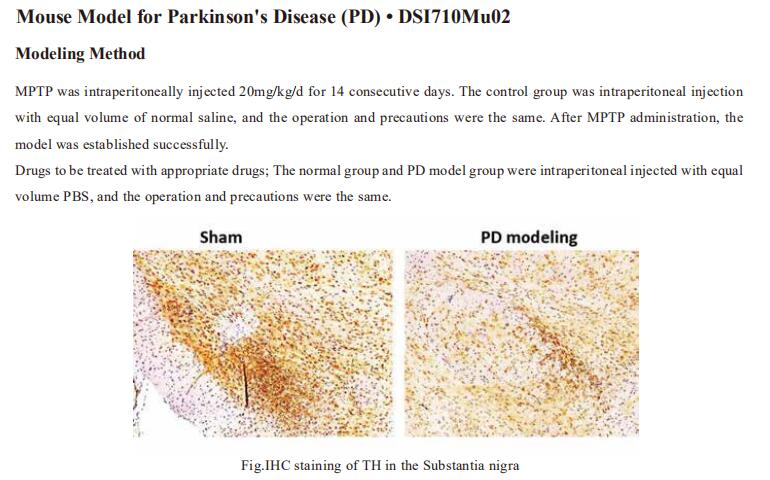New findings in neurodegenerative diseases
Neurodegenerative diseases are caused by the progressive loss of function or structure of nerve cells in the central nervous system. The most common neurodegenerative diseases include Alzheimer's disease(AD), Huntington's disease, motor neuron disease,and Parkinson's disease(PD). Although the physical or mental symptoms of neurodegenerative disease may be relieved by various treatment combinations, there are currently no strategies to directly slow or prevent neurodegeneration. Given the demographic evidence of a rapidly growing aging population and the associated prevalence of these common neurodegenerative diseases, it is paramount to develop safe and effective ways to protect against neurodegenerative diseases.
1. Cholesterol and matrisome pathways dysregulated in astrocytes and microglia
The impact of apolipoprotein E ε4 (APOE4), the strongest genetic risk factor for AD, on human brain cellular function remains unclear. Alison M. Goate, Department of Genetics and Genomic Sciences, Icahn School of Medicine at Mount Sinai, USA, and his team investigated the effects of APOE4 on brain cell types derived from population and isogenic human induced pluripotent stem cells, post-mortem brain, and APOE targeted replacement mice[1]. Population and isogenic models demonstrate that APOE4 local haplotype, rather than a single risk allele, contributes to risk. Global transcriptomic analyses reveal human-specific, APOE4- driven lipid metabolic dysregulation in astrocytes and microglia. APOE4 enhances de novo cholesterol synthesis despite elevated intracellular cholesterol due to lysosomal cholesterol sequestration in astrocytes. Further, matrisome dysregulation is associated with upregulated chemotaxis, glial activation, and lipid biosynthesis in astrocytes co-cultured with neurons, which recapitulates altered astrocyte matrisome signaling in human brain(Fig.1). Thus, APOE4 initiates glia-specific cell and non-cell autonomous dysregulation that may contribute to increased AD risk.
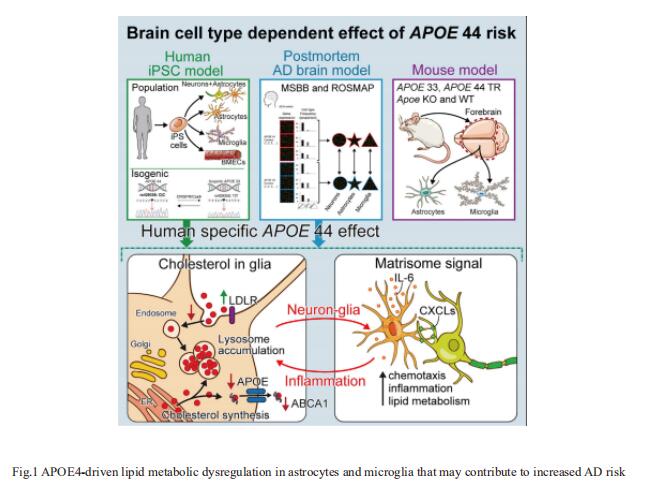
2. Homotypic fibrillization of TMEM106B across diverse neurodegenerative diseases
Misfolding and aggregation of disease-specific proteins, resulting in the formation of filamentous cellular inclusions, is a hallmark of neurodegenerative disease with characteristic filament structures, or conformers, defining each proteinopathy. Anthony W.P. Fitzpatrick, Mortimer B. Zuckerman Mind Brain Behavior Institute, Columbia University, USA, and his team showed that a previously unsolved amyloid fibril composed of a 135 amino acid C-terminal fragment of TMEM106B is a common finding in distinct human neurodegenerative diseases, including cases characterized by abnormal aggregation of TDP-43, tau, or a-synuclein protein(Fig.2)[2]. A combination of cryoelectron microscopy and mass spectrometry was used to solve the structures of TMEM106B fibrils from postmortem human brain tissue afflicted with frontotemporal lobar degeneration with TDP-43 pathology, progressive supranuclear palsy, or dementia with Lewy bodies. The commonality of abundant amyloid fibrils composed of TMEM106B, a lysosomal/endosomal protein, to a broad range of debilitating human disorders indicates a shared fibrillization pathway that may initiate or accelerate neurodegeneration.
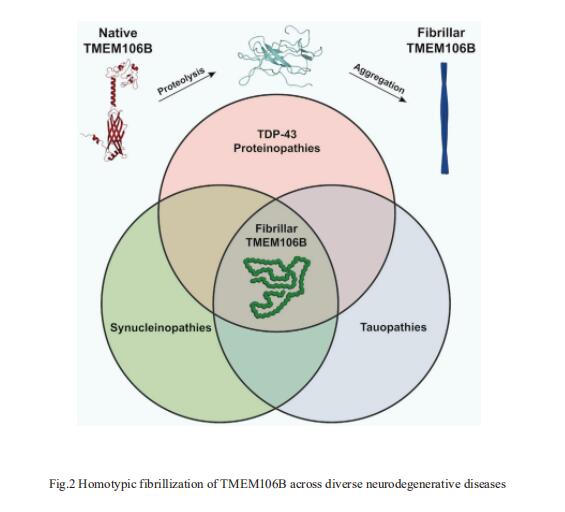
3. PAAN/MIF nuclease inhibition prevents neurodegeneration in Parkinson’s disease
Parthanatos-associated apoptosis-inducing factor (AIF) nuclease (PAAN), also known as macrophage migration inhibitor factor (MIF), acts as a final executioner in parthanatos. Valina L. Dawson, Neuroregeneration and Stem Cell Programs, Institute for Cell Engineering, Johns Hopkins University School of Medicine, USA, and his team showed that neurodegeneration induced by pathologic a-synuclein (a-syn) occurs via PAAN/MIF nuclease activity[3]. Genetic depletion of PAAN/MIF and a mutant lacking nuclease activity prevent the loss of dopaminergic neurons and behavioral deficits in the a-syn preformed fibril (PFF) mouse model of sporadic PD. Compound screening led to the identification of PAANIB-1, a brain-penetrant PAAN/MIF nuclease inhibitor that prevents neurodegeneration induced by a-syn PFF, AAV-a-syn overexpression, or MPTP intoxication in vivo(Fig.3).Since increasing evidence indicates that parthanatos play a prominent role in a wide range of neurologic diseases, including stroke, PD, amyotrophic lateral sclerosis, and AD, the therapeutic utility of PAAN/MIF nuclease inhibition will likely extend to other forms of neurodegeneration and cell death where parthanatos plays a role.
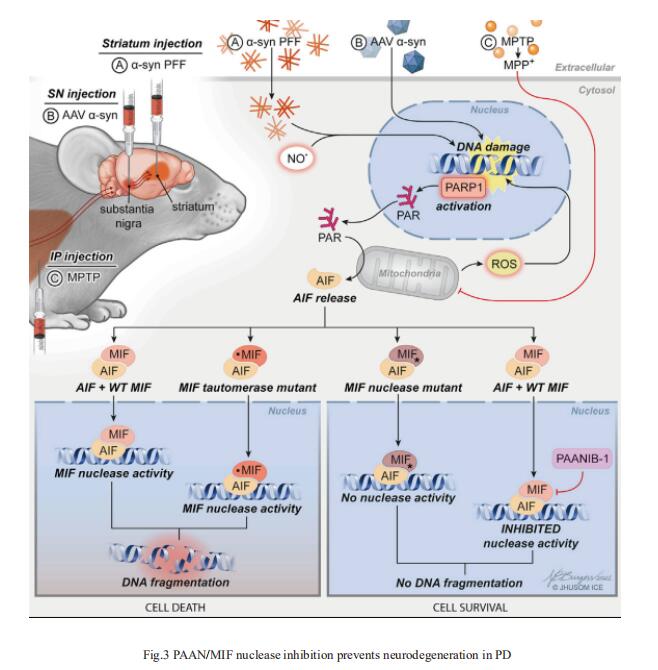
4. Structural basis of SARM1 activation, substrate recognition, and inhibition by small molecules
The NADase SARM1 (sterile alpha and TIR motif containing 1) is a key executioner of axon degeneration and a therapeutic target for several neurodegenerative conditions. Thomas Ve, Institute for Glycomics, Griffith University, Australia, and his team showed that a potent SARM1 inhibitor undergoes base exchange with the nicotinamide moiety of nicotinamide adenine dinucleotide (NAD+ ) to produce the bona fide inhibitor 1AD[4]. They reported structures of SARM1 in complex with 1AD, NAD+ mimetics and the allosteric activator nicotinamide mononucleotide (NMN). NMN binding triggers reorientation of the armadillo repeat (ARM) domains, which disrupts ARM:TIR interactions and leads to formation of a two-stranded TIR domain assembly(Fig.4). The active site spans two molecules in these assemblies, explaining the requirement of TIR domain self-association for NADase activity and axon degeneration. The results reveal the mechanisms of SARM1 activation and substrate binding, providing rational avenues for the design of new therapeutics targeting SARM1.
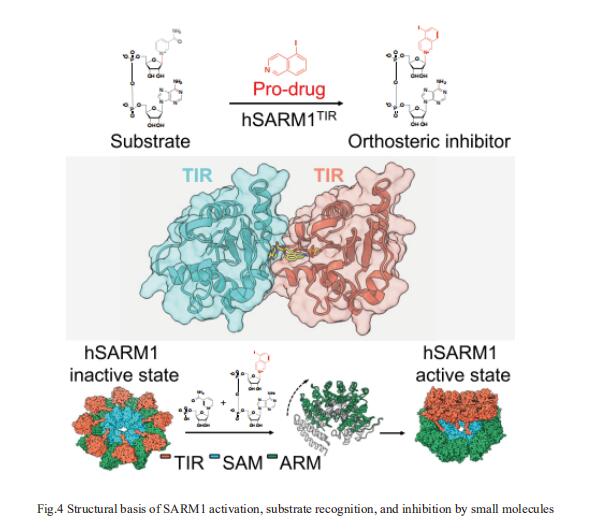
References
[1]Tcw J, Qian L, Pipalia NH, et al. Cholesterol and matrisome pathways dysregulated in astrocytes and microglia[J]. Cell. 2022,185(13):2213-2233.e25. (IF=66.850)
[2]Chang A, Xiang X, Wang J, et al. Homotypic fibrillization of TMEM106B across diverse neurodegenerative diseases[J]. Cell. 2022, 185(8):1346-1355.e15. (IF=66.850)
[3]Park H, Kam TI, Peng H, et al. PAAN/MIF nuclease inhibition prevents neurodegeneration in Parkinson's disease[J]. Cell. 2022, 185(11):1943-1959.e21. (IF=66.850)
[4]Shi Y, Kerry PS, Nanson JD, et al. Structural basis of SARM1 activation, substrate recognition, and inhibition by small molecules[J]. Mol Cell. 2022, 82(9):1643-1659.e10. (IF=19.328)
Cloud-Clone can not only provide animal models of a variety of neurological diseases, including Alzheimer's disease, Parkinson's disease, anxiety disorder, chronic stress depression, schizophrenia, etc., covering common neurological diseases. We also have various neurological disease detection indicators and related products such as APOE, TMEM106B, TDP-43, Tau and a-synuclein, which can help the majority of scientific researchers to carry out researches on neurological diseases.
